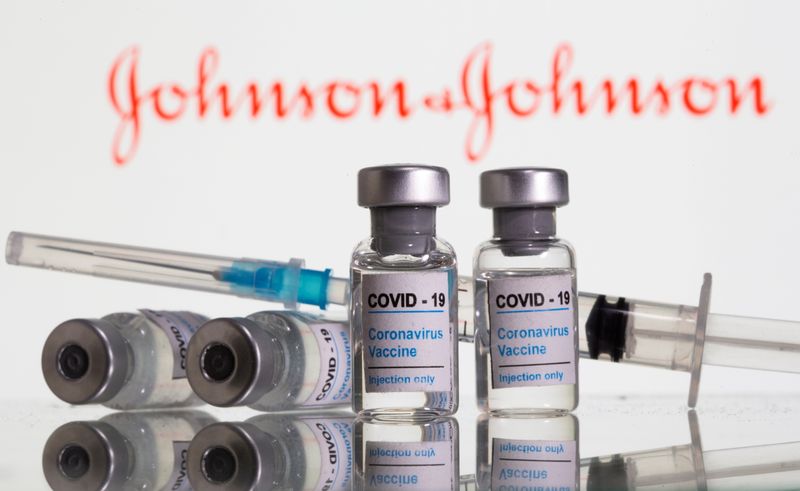By Francesco Guarascio, Emilio Parodi and Matthias Blamont
BRUSSELS (Reuters) - At the height of Europe's vaccine supply crisis in March, Johnson & Johnson (NYSE:JNJ)'s (J&J) single-dose COVID-19 vaccine was touted as a game-changer. But two months into its rollout, the shot has the lowest uptake of all four approved vaccines.
Supply problems, safety concerns, improved deliveries of rival vaccines and countries' inoculation strategies have all played a part in holding back usage.
Despite the shot's clear logistical advantage of not requiring a booster, the European Union has only administered about half of the delivered doses - an uptake rate much lower than any rival COVID-19 vaccine, including AstraZeneca (NASDAQ:AZN)'s, which has also been dogged by supply and safety issues.
That is bad news for J&J, and also raises questions about the efficiency of the EU's inoculation campaign, as the bloc's drugs regulator insists the shot can save lives.
Supply problems in particular have soured the mood in Brussels, which has already decided not to take up an option to order 100 million additional doses of the J&J vaccine, and has not yet decided whether to exercise a second one for another 100 million shots which lapses at the end of June.
EU sources say that if ordered, the extra doses will most likely be donated to countries outside the bloc.
The shot has also struggled in the U.S. market.
HIGH HOPES
Three months ago, the situation was very different.
"A single dose vaccine can make a difference in the speed of rollout," EU health commissioner Stella Kyriakides said on March 11, the day J&J's shot was approved for use in the EU.
At that time, the 27-nation bloc's vaccination drive was struggling, largely due to big cuts in expected supplies from AstraZeneca. And the J&J shot, initially expected to arrive at the start of April, was seen as crucial to building momentum.
Despite a two-week delay in the rollout, EU officials were still upbeat. "The vaccine will massively accelerate the pace in the EU," the bloc's top lawmaker on health matters, Peter Liese, said on April 12.
But two months later, only about 12 million doses have been delivered to the EU out of the 55 million expected by the end of June. Production problems at J&J subcontractor Emergent led the EU to refuse about 20 million doses this month, and the bloc does not expect J&J to meet delivery targets.
Of the doses supplied, only about half - or around six million - have been administered, according to data from the European Centre for Disease prevention and Control (ECDC), the lowest uptake of the four COVID-19 shots approved by the European Medicines Agency (EMA).
By comparison, as of Tuesday, over 90% of the about 250 million vaccines shipped by Pfizer (NYSE:PFE) and its partner BioNTech have been administered, and nearly 85% of the over 30 million Moderna (NASDAQ:MRNA) doses have been used.
Around 75% of AstraZeneca's nearly 70 million delivered shots have also been injected into EU arms.
In France, the EU's second most populous country, the uptake of J&J's vaccine was half the bloc's average - at just 22% of the delivered doses in mid-June, a French health ministry official said, whereas the utilisation rates for the Pfizer and Moderna shots were well above 80%, and over 60% for AstraZeneca.
The gap is even more striking when considering the stock of these two-dose vaccines needs to be managed carefully to ensure a second dose is available within the prescribed interval. Such precautions are not needed for the single-dose J&J vaccine.
A European Commission spokesperson declined to comment on the low uptake, while adding the Commission and governments were "for the moment of course disappointed with the numbers of deliveries, but they hope that these deliveries will increase over time."
J&J has repeatedly said it will deliver the 200 million doses ordered by the EU, but has declined to comment on the second-quarter target and on the low uptake.
VACCINE FOR THE ISLANDS
One reason for the low usage is that the J&J shot was briefly suspended, and has faced some restrictions, due to its links to very rare, but potentially fatal, blood clotting.
AstraZeneca's vaccine has faced similar safety-related hurdles and stricter limitations on its use in the EU, but still has a higher take-up.
However, AstraZeneca's potential safety issues emerged only after it had been administered to many people in Europe, whereas J&J's possible side-effects were known even before its rollout on the continent, after its deployment in the United States.
"There is no strategic reason for the low administration of this vaccine," said Guido Rasi, former director of the EMA and currently adviser to the Italian government on the COVID-19 emergency.
He said one of the explanations for the low uptake was that J&J's vaccine became available after other shots, when many of the most vulnerable people had already been inoculated, making its use less pressing.

Ironically, the logistical advantage it offers may also have reduced its use, as authorities sought to deploy it in more remote regions with fewer people.
"Being a single-dose jab, it has been seen as preferable to administer it in places where it would be more problematic to administer the vaccines twice, such as islands and those parts of the country that are more difficult to reach," Rasi said.